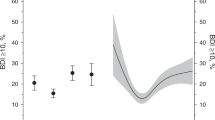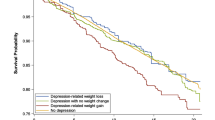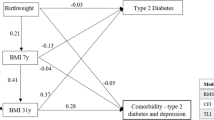Abstract
Background:
Obesity is associated with an increased risk of developing a variety of chronic diseases, most of which are associated with psychiatric disorders. We examined the associations of depression and anxiety with body mass index (BMI) after taking into consideration the obesity-related comorbidities (ORCs) and other psychosocial or lifestyle factors.
Methods:
We analyzed the data collected from 177 047 participants (aged⩾18 years) in the 2006 Behavioral Risk Factor Surveillance System. Current depression was assessed by the Patient Health Questionnaire-8 diagnostic algorithm. Lifetime diagnoses of depression, anxiety and ORCs were self-reported. The prevalence of the three psychiatric disorders was age standardized to the 2000 US population. Multivariate-adjusted prevalence ratios were computed to test associations of depression and anxiety with BMI using SUDAAN software.
Results:
The age-adjusted prevalence of current depression, lifetime diagnosed depression and anxiety varied significantly by gender. Within each gender, the prevalence of the three psychiatric disorders was significantly higher in both men and women who were underweight (BMI<18.5 kg/m2), in women who were overweight (BMI: 25–<30 kg/m2) or obese (BMI⩾30 kg/m2), and in men who had class III obesity (BMI⩾40 kg/m2) than in those with a normal BMI (18.5−<25 kg/m2). After adjusting for demographics, ORCs, lifestyle or psychosocial factors, compared with men with a normal BMI, men with a BMI⩾40 kg/m2 were significantly more likely to have current depression or lifetime diagnosed depression and anxiety; men with a BMI<18.5 kg/m2 were also significantly more likely to have lifetime diagnosed depression. Women who were either overweight or obese were significantly more likely than women with a normal BMI to have all the three psychiatric disorders.
Conclusions:
Our results demonstrate that disparities in the prevalence of depression and anxiety exist among people with different BMI levels independent of their disease status or other psychosocial or lifestyle factors.
This is a preview of subscription content, access via your institution
Access options
Subscribe to this journal
Receive 12 print issues and online access
$259.00 per year
only $21.58 per issue
Buy this article
- Purchase on Springer Link
- Instant access to full article PDF
Prices may be subject to local taxes which are calculated during checkout



Similar content being viewed by others
References
Kessler RC, Chiu WT, Demler O, Merikangas KR, Walters EE . Prevalence, severity, and comorbidity of 12-month DSM-IV disorders in the National Comorbidity Survey Replication. Arch Gen Psychiatry 2005; 62: 617–627.
Kessler RC, Wang PS . The descriptive epidemiology of commonly occurring mental disorders in the United States. Annu Rev Public Health 2008; 29: 115–129.
President's New Freedom Commission on Mental Health (U.S.). Achieving the promise: transforming mental health care in America. Department of Health and Human Services, US: Rockville, MD, 2003.
Centers for Disease Control and Prevention. BRFSS trend data, available at URL http://apps.nccd.cdc.gov/brfss/display.asp?cat=OB&yr=2007&qkey=4409&state=US (Accessed on May 20 2008).
Freedman DS, Khan LK, Serdula MK, Galuska DA, Dietz WH . Trends and correlates of class 3 obesity in the United States from 1990 through 2000. JAMA 2002; 288: 1758–1761.
Ogden CL, Carroll MD, Curtin LR, McDowell MA, Tabak CJ, Flegal KM . Prevalence of overweight and obesity in the United States, 1999–2004. JAMA 2006; 295: 1549–1555.
Barry D, Pietrzak RH, Petry NM . Gender differences in associations between body mass index and DSM-IV mood and anxiety disorders: results from the national epidemiologic survey on alcohol and related conditions. Ann Epidemiol 2008; 18: 458–466.
Bjerkeset O, Romundstad P, Evans J, Gunnell D . Association of adult body mass index and height with anxiety, depression, and suicide in the general population: the HUNT study. Am J Epidemiol 2008; 167: 193–202.
Kasen S, Cohen P, Chen H, Must A . Obesity and psychopathology in women: a three decade prospective study. Int J Obes (Lond) 2008; 32: 558–566.
Petry NM, Barry D, Pietrzak RH, Wagner JA . Overweight and obesity are associated with psychiatric disorders: results from the National Epidemiologic Survey on Alcohol and Related Conditions. Psychosom Med 2008; 70: 288–297.
Scott KM, McGee MA, Wells JE, Oakley Browne MA . Obesity and mental disorders in the adult general population. J Psychosom Res 2008; 64: 97–105.
Simon GE, Von KM, Saunders K, Miglioretti DL, Crane PK, van BG et al. Association between obesity and psychiatric disorders in the U.S. adult population. Arch Gen Psychiatry 2006; 63: 824–830.
Strine TW, Mokdad AH, Dube SR, Balluz LS, Gonzalez O, Berry JT et al. The association of depression and anxiety with obesity and unhealthy behaviors among community-dwelling U.S. adults. Gen Hosp Psychiatry 2008; 30: 127–137.
Pickering RP, Grant BF, Chou SP, Compton WM . Are overweight, obesity, and extreme obesity associated with psychopathology? Results from the national epidemiologic survey on alcohol and related conditions. J Clin Psychiatry 2007; 68: 998–1009.
Onyike CU, Crum RM, Lee HB, Lyketsos CG, Eaton WW . Is obesity associated with major depression? Results from the Third National Health and Nutrition Examination Survey. Am J Epidemiol 2003; 158: 1139–1147.
Simon GE, Ludman EJ, Linde JA, Operskalski BH, Ichikawa L, Rohde P et al. Association between obesity and depression in middle-aged women. Gen Hosp Psychiatry 2008; 30: 32–39.
Hamer M, Stamatakis E, Steptoe A . Dose response relationship between physical activity and mental health: The Scottish Health Survey. Br J Sports Med 2008, online doi:10.1136/bjsm.2008.046243.
Heo M, Pietrobelli A, Fontaine KR, Sirey JA, Faith MS . Depressive mood and obesity in U.S. adults: comparison and moderation by sex, age, and race. Int J Obes (Lond) 2006; 30: 513–519.
Sachs-Ericsson N, Burns AB, Gordon KH, Eckel LA, Wonderlich SA, Crosby RD et al. Body mass index and depressive symptoms in older adults: the moderating roles of race, sex, and socioeconomic status. Am J Geriatr Psychiatry 2007; 15: 815–825.
Bjerkeset O, Nordahl HM, Mykletun A, Holmen J, Dahl AA . Anxiety and depression following myocardial infarction: gender differences in a 5-year prospective study. J Psychosom Res 2005; 58: 153–161.
Fan AZ, Strine TW, Jiles R, Mokdad AH . Depression and anxiety associated with cardiovascular disease among persons aged 45 years and older in 38 states of the United States, 2006. Prev Med 2008; 46: 445–450.
Herbst S, Pietrzak RH, Wagner J, White WB, Petry NM . Lifetime major depression is associated with coronary heart disease in older adults: results from the National Epidemiologic Survey on Alcohol and Related Conditions. Psychosom Med 2007; 69: 729–734.
Li C, Ford ES, Strine TW, Mokdad AH . Prevalence of depression among U.S. adults with diabetes: findings from the 2006 behavioral risk factor surveillance system. Diabetes Care 2008; 31: 105–107.
Watkins LL, Blumenthal JA, Davidson JR, Babyak MA, McCants Jr CB, Sketch Jr MH . Phobic anxiety, depression, and risk of ventricular arrhythmias in patients with coronary heart disease. Psychosom Med 2006; 68: 651–656.
Das-Munshi J, Stewart R, Ismail K, Bebbington PE, Jenkins R, Prince MJ . Diabetes, common mental disorders, and disability: findings from the UK National Psychiatric Morbidity Survey. Psychosom Med 2007; 69: 543–550.
John U, Meyer C, Rumpf HJ, Hapke U . Relationships of psychiatric disorders with overweight and obesity in an adult general population. Obes Res 2005; 13: 101–109.
Lawlor DA, Hart CL, Hole DJ, Gunnell D, Davey SG . Body mass index in middle life and future risk of hospital admission for psychoses or depression: findings from the Renfrew/Paisley study. Psychol Med 2007; 37: 1151–1161.
Carpenter KM, Hasin DS, Allison DB, Faith MS . Relationships between obesity and DSM-IV major depressive disorder, suicide ideation, and suicide attempts: results from a general population study. Am J Public Health 2000; 90: 251–257.
Palinkas LA, Wingard DL, Barrett-Connor E . Depressive symptoms in overweight and obese older adults: a test of the ‘jolly fat’ hypothesis. J Psychosom Res 1996; 40: 59–66.
Mokdad AH, Stroup DF, Giles WH . Public health surveillance for behavioral risk factors in a changing environment. Recommendations from the Behavioral Risk Factor Surveillance Team. MMWR Recomm Rep 2003; 52: 1–12.
Nelson DE, Holtzman D, Bolen J, Stanwyck CA, Mack KA . Reliability and validity of measures from the Behavioral Risk Factor Surveillance System (BRFSS). Soz Praventivmed 2001; 46 (Suppl 1): S3–42.
Nelson DE, Powell-Griner E, Town M, Kovar MG . A comparison of national estimates from the National Health Interview Survey and the Behavioral Risk Factor Surveillance System. Am J Public Health 2003; 93: 1335–1341.
Cannon DS, Tiffany ST, Coon H, Scholand MB, McMahon WM, Leppert MF . The PHQ-9 as a brief assessment of lifetime major depression. Psychol Assess 2007; 19: 247–251.
Kroenke K, Spitzer RL, Williams JB . The PHQ-9: validity of a brief depression severity measure. J Gen Intern Med 2001; 16: 606–613.
Martin A, Rief W, Klaiberg A, Braehler E . Validity of the brief patient health questionnaire mood scale (PHQ-9) in the general population. Gen Hosp Psychiatry 2006; 28: 71–77.
Pinto-Meza A, Serrano-Blanco A, Penarrubia MT, Blanco E, Haro JM . Assessing depression in primary care with the PHQ-9: can it be carried out over the telephone? J Gen Intern Med 2005; 20: 738–742.
National Institutes of Health. Clinical guidelines on the identification, evaluation, and treatment of overweight and obesity in adults. DHHS, NIH, NHLBI: Bethesda, MD, 1998. Available at URL http://www.nhlbi.nih.gov/guidelines/obesity/ob_gdlns.pdf Accessed on 20 May 2008.
Friedman N, Fanning EL . Overweight and obesity: an overview of prevalence, clinical impact, and economic impact. Dis Manag 2004; 7 (Suppl 1): S1–S6.
Mokdad AH, Ford ES, Bowman BA, Dietz WH, Vinicor F, Bales VS et al. Prevalence of obesity, diabetes, and obesity-related health risk factors, 2001. JAMA 2003; 289: 76–79.
Jorm AF, Korten AE, Christensen H, Jacomb PA, Rodgers B, Parslow RA . Association of obesity with anxiety, depression and emotional well-being: a community survey. Aust N Z J Public Health 2003; 27: 434–440.
Yun S, Zhu BP, Black W, Brownson RC . A comparison of national estimates of obesity prevalence from the behavioral risk factor surveillance system and the National Health and Nutrition Examination Survey. Int J Obes (Lond) 2006; 30: 164–170.
Sullivan PW, Ghushchyan V, Wyatt HR, Wu EQ, Hill JO . Impact of cardiometabolic risk factor clusters on health-related quality of life in the U.S. Obesity (Silver Spring) 2007; 15: 511–521.
Kolotkin RL, Crosby RD, Williams GR, Hartley GG, Nicol S . The relationship between health-related quality of life and weight loss. Obes Res 2001; 9: 564–571.
Burgmer R, Petersen I, Burgmer M, de Zwaan M, Wolf AM, Herpertz S . Psychological outcome two years after restrictive bariatric surgery. Obes Surg 2007; 17: 785–791.
Björntorp P . Do stress reactions cause abdominal obesity and comorbidities? Obes Rev 2001; 2: 73–86.
Weber-Hamann B, Werner M, Hentschel F, Bindeballe N, Lederbogen F, Deuschle M et al. Metabolic changes in elderly patients with major depression: evidence for increased accumulation of visceral fat at follow-up. Psychoneuroendocrinology 2006; 31: 347–354.
Antony MM, Johnson WG, Carr-Nangle RE, Abel JL . Psychopathology correlates of binge eating and binge eating disorder. Compr Psychiatry 1994; 35: 386–392.
Specker S, de Zwaan M, Raymond N, Mitchell J . Psychopathology in subgroups of obese women with and without binge eating disorder. Compr Psychiatry 1994; 35: 185–190.
Colles SL, Dixon JB, O′Brien PE . Loss of control is central to psychological disturbance associated with binge eating disorder. Obesity (Silver Spring) 2008; 16: 608–614.
Breslin FC, Gnam W, Franche RL, Mustard C, Lin E . Depression and activity limitations: examining gender differences in the general population. Soc Psychiatry Psychiatr Epidemiol 2006; 41: 648–655.
Broadhead WE, Blazer DG, George LK, Tse CK . Depression, disability days, and days lost from work in a prospective epidemiologic survey. JAMA 1990; 264: 2524–2528.
Carroll BJ, Cassidy F, Naftolowitz D, Tatham NE, Wilson WH, Iranmanesh A et al. Pathophysiology of hypercortisolism in depression. Acta Psychiatr Scand Suppl 2007; 433: 90–103.
Abelson JL, Khan S, Liberzon I, Young EA . HPA axis activity in patients with panic disorder: review and synthesis of four studies. Depress Anxiety 2007; 24: 66–76.
Rosmond R, Dallman MF, Bjorntorp P . Stress-related cortisol secretion in men: relationships with abdominal obesity and endocrine, metabolic and hemodynamic abnormalities. J Clin Endocrinol Metab 1998; 83: 1853–1859.
Golden SH . A review of the evidence for a neuroendocrine link between stress, depression and diabetes mellitus. Curr Diabetes Rev 2007; 3: 252–259.
Laimer M, Kramer-Reinstadler K, Rauchenzauner M, Lechner-Schoner T, Strauss R, Engl J et al. Effect of mirtazapine treatment on body composition and metabolism. J Clin Psychiatry 2006; 67: 421–424.
Murray J, Lopez A (eds). Summary: The Global Burden of Disease. Harvard School of Public Health: Boston, MA, 1996.
Carnethon MR, Biggs ML, Barzilay JI, Smith NL, Vaccarino V, Bertoni AG et al. Longitudinal association between depressive symptoms and incident type 2 diabetes mellitus in older adults: the cardiovascular health study. Arch Intern Med 2007; 167: 802–807.
Surtees PG, Wainwright NW, Luben RN, Wareham NJ, Bingham SA, Khaw KT . Psychological distress, major depressive disorder, and risk of stroke. Neurology 2008; 70: 788–794.
Surtees PG, Wainwright NW, Luben RN, Wareham NJ, Bingham SA, Khaw KT . Depression and Ischemic Heart Disease Mortality: Evidence From the EPIC-Norfolk United Kingdom Prospective Cohort Study. Am J Psychiatry 2008; 165: 515–523.
Author information
Authors and Affiliations
Corresponding author
Additional information
Conflict of interest
None.
Disclaimer
The findings and conclusions in this article are those of the authors and do not necessarily represent the official position of the Centers for Disease Control and Prevention.
Rights and permissions
About this article
Cite this article
Zhao, G., Ford, E., Dhingra, S. et al. Depression and anxiety among US adults: associations with body mass index. Int J Obes 33, 257–266 (2009). https://doi.org/10.1038/ijo.2008.268
Received:
Revised:
Accepted:
Published:
Issue Date:
DOI: https://doi.org/10.1038/ijo.2008.268
Keywords
This article is cited by
-
Multiple mediation of the association between childhood emotional abuse and adult obesity by anxiety and bulimia – a sample from bariatric surgery candidates and healthy controls
BMC Public Health (2024)
-
Influence of body mass index on health complains and life satisfaction
Quality of Life Research (2024)
-
Risk factors of persistent adolescent thinness: findings from the UK Millennium Cohort Study
BMC Public Health (2023)
-
Taste receptor type 1 member 3 enables western diet-induced anxiety in mice
BMC Biology (2023)
-
A modern web-based health promotion program for patients in Greece with diabetes 2 and obesity: an interventional study
BMC Public Health (2023)



